News
Singapore Ranks 5th Least Corrupt Country In 2022 Corruption Perceptions Index
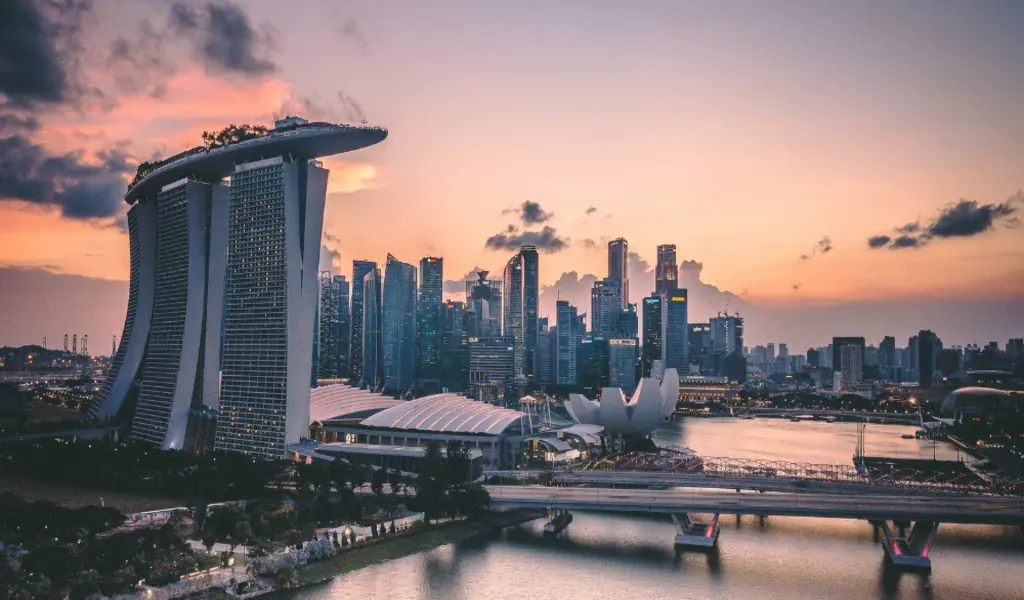
(CTN NEWS) – Singapore is the least corrupt nation in Asia, according to global anti-corruption watchdog Transparency International, with the Republic placing fifth worldwide on the group’s Corruption Perceptions Index (CPI).
However, given that Transparency International revised the scoring metric in 2012 when Singapore attained a high of 87 points, it did so with its lowest score in ten years.
The CPI polls professionals and businesspeople and ranks 180 nations and territories according to their perceived levels of public sector corruption on a scale of 0 to 100.
Singapore and Sweden both received 83 points in the 2022 index. They fell short of Norway (87), New Zealand (87), Finland (87), Denmark (90), and (84).
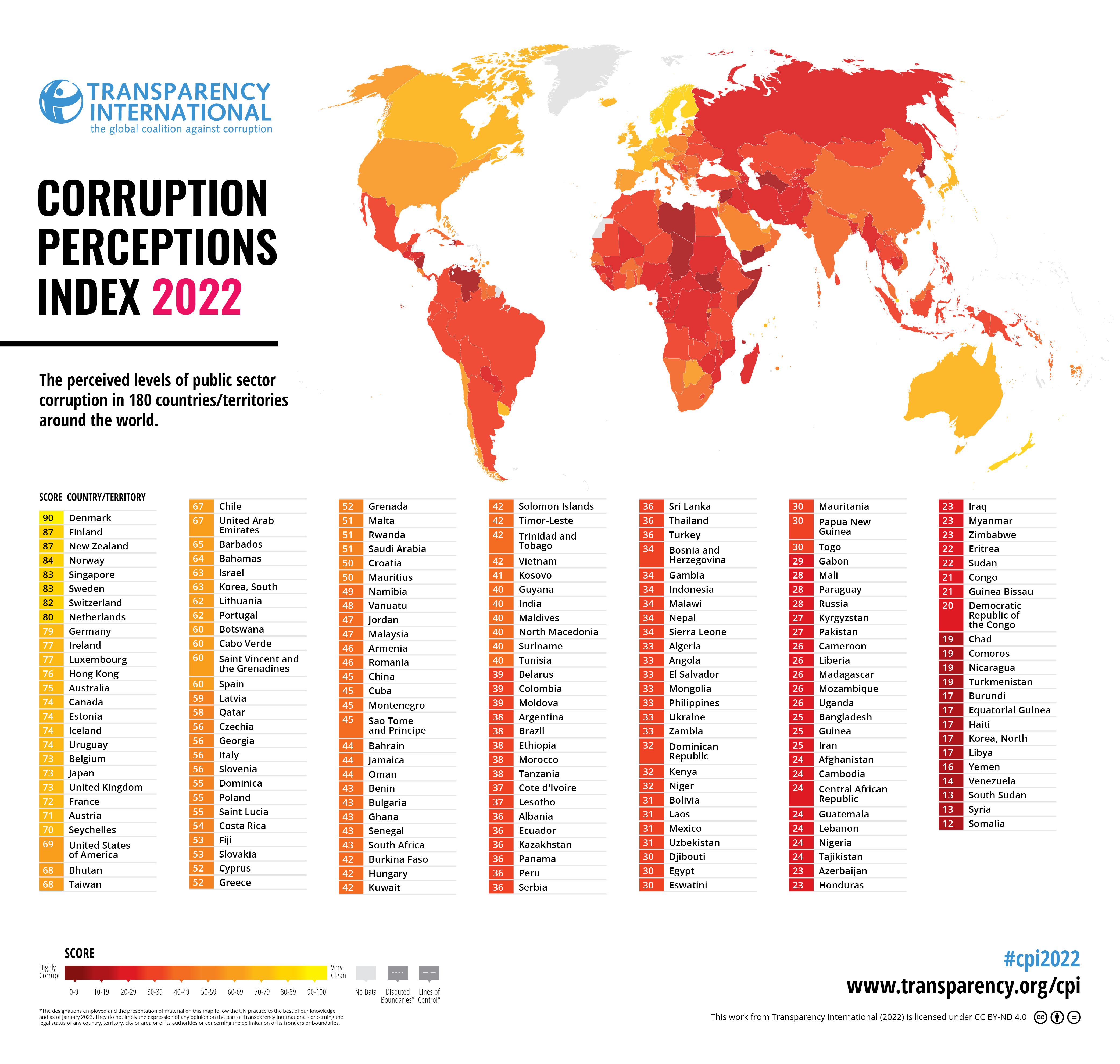
Photo from Transparency Internation
In the 2021 index, the Republic came in fourth place, tied with Norway and Sweden at 85 points, just one point behind leaders Denmark, Finland, and New Zealand, which all received 88 points.
Transparency International stated in research released Tuesday that the 2022 CPI analyses the relationship between conflict, security, and corruption.
Taking a close look at how violence and corruption affect one another globally.
The paper claimed that a new wave of uncertainty is being fueled by the COVID-19 epidemic, the climate problem, and mounting security concerns globally, with countries failing to combat corruption worsening the effects.
Two-thirds of the jurisdictions’ scores for the 2022 CPI fall below the global average of 43, which is 43.
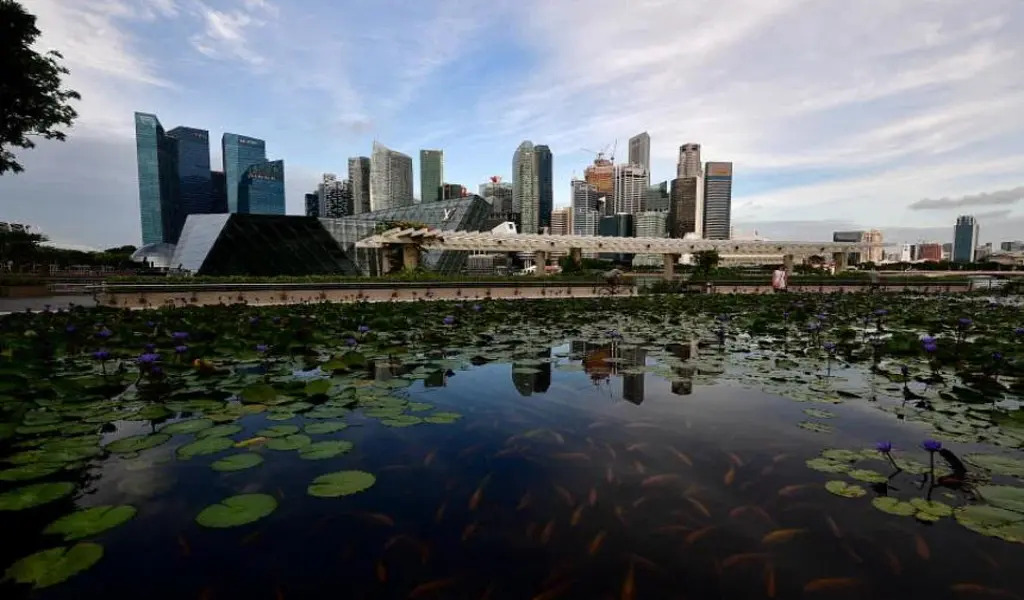
In the 2022 index, Singapore scored 83 points. It was ranked behind Denmark (90), Finland (87), New Zealand (87) and Norway (84). ST PHOTO: LIM YAOHUIThe head of Transparency International, Ms. Delia Ferreira Rubio, asserted that corruption has increased danger in the world.
According to the attorney, governments have collectively failed to combat it, which fuels the current uptick in violence and conflict and puts everyone in danger.
The only solution is for states to put in the effort and eliminate corruption at all levels to make sure that governments serve all citizens, not just a select few.
Singapore came in second place in the Asia-Pacific area, trailing only New Zealand (87).
Hong Kong (76), Australia (75), and Japan came in last (73).
According to the research, the Asia-Pacific region’s average score of 45 points has remained unchanged for the fourth consecutive year.
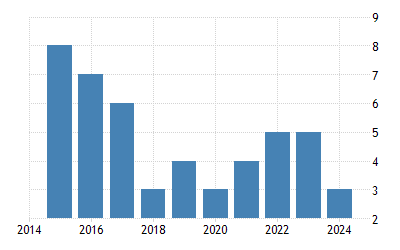
/ GETTY IMAGE
Asia Pacific’s Top 10 Countries For 2022
| 1 | New Zealand | 87 |
|---|---|---|
| 2 | Singapore | 83 |
| 3 | Hong Kong | 76 |
| 4 | Australia | 75 |
| 5 | Japan | 73 |
| 6 | Bhutan | 68 |
| 6 | Taiwan | 68 |
| 8 | South Korea | 63 |
| 9 | Fiji | 53 |
| 10 | Vanuatu | 48 |
It stated that authoritarianism has been increasing in the area and noted that the pandemic-era limits on civic space and fundamental liberties have persisted.
The report also pointed out that Asian leaders have prioritized economic recovery over other matters.
Singapore has continuously performed well in the rankings, maintaining its position as one of the best nations worldwide and in Asia, according to Ms. Ilham Mohamed, Transparency International’s regional adviser for Asia.
She lauded Singapore’s Corrupt Practices Investigation Bureau (CPIB), describing it as a top-notch organisation with a solid reputation for combating corruption.
She continued by pointing out that while Singapore remains a leader in the battle against corruption, there is still room for improvement.
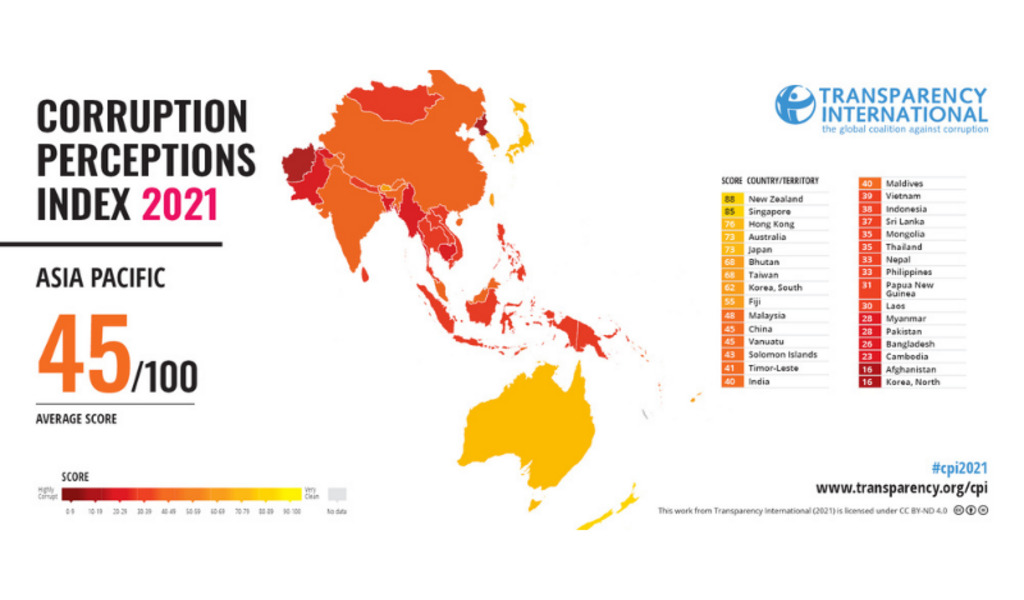
Photo from Transparency Internation
It is not merely a two-point decline from the prior year, according to Ms. Ilham. Singapore has stagnated in the last 10 years and experienced a minor decline.
She explained that Singapore needs to address two primary problems when asked why this was the case.
These included cross-border illicit cash flows and having more public forums to speak out against corruption.
“Many advanced economies in Asia are also failing at this when it comes to illegal finance flows,” she said.
One crucial aspect of such economies is permitting the establishment of covert organizations and shell corporations that transfer money internationally.
“Politically exposed individuals employ this in addition to criminals. Additionally, big corruption in politics is frequently associated.
Singapore has “extremely robust banking systems,” she continued, but it must make sure the money kept in its financial institutions is clean.
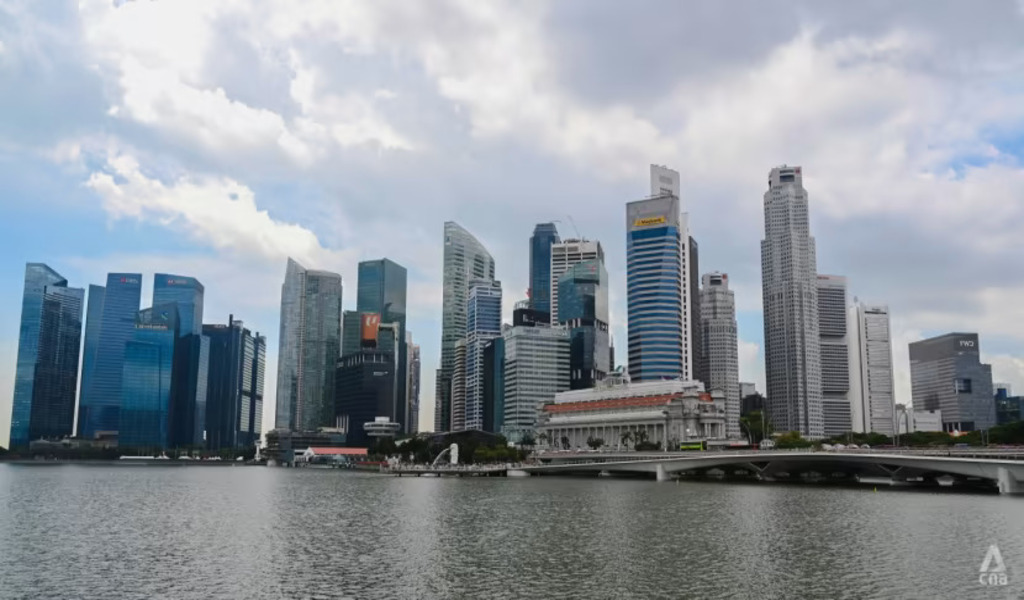
File photo of skyline buildings of the Central Business District in Singapore on Nov 16, 2022. (Photo: CNA/Hanidah Amin)
Top 10 Countries And Territories for 2022
| 1 | Denmark | 90 |
|---|---|---|
| 2 | Finland | 87 |
| 2 | New Zealand | 87 |
| 4 | Norway | 84 |
| 5 | Singapore | 83 |
| 5 | Sweden | 83 |
| 7 | Switzerland | 82 |
| 8 | Netherlands | 80 |
| 9 | Germany | 79 |
| 10 | Ireland | 77 |
According to Ms. Ilham, Singapore lacks civic venues where people can speak in public.
She stated that there must be a platform for protestors, journalists, and activists to safely expose corruption through demonstrations and whistle-blowing.
“People won’t denounce corruption if civic space is not provided, you’ll find.’
Even in an anti-corruption organization that is correctly set up, reporting and whistleblowing are crucial.
She added that there aren’t many non-governmental organizations fighting corruption in Singapore.
The CPI’s drawback, according to Ms. Ilham, is that occasionally it can give the impression that the jurisdictions with the best performance are free of issues.
Because Singapore is so far ahead of other nations, she explained, “the issue with a 0 to 100 score and rating is that it makes the country look like it doesn’t have any difficulties.”
“Singapore could appear incredibly clean if you contrast it with Afghanistan, North Korea, or even Cambodia.
“However, Singapore should compare itself to what it could be. Singapore can try to set even higher standards.
When asked if Singapore could ever achieve a CPI score above 90, Ms. Ilham said it was highly likely.
Singapore possesses a full range of administrative competence and aptitude. More so, she continued, “it’s about complementing what it already has.
“I believe Singapore can actively take on a bigger leadership position in the area, serving as a role model in the battle against corruption.”

/ CPI 2021
Statement From CPIB
In a statement on Tuesday, CPIB said that Singapore’s corruption problem is still firmly in check and stated that the nation scored highly on worldwide incorruptibility and public sector cleanliness indices.
“Singapore was recognized as the least corrupt nation out of 16 economies in The Political and Economic Risk Consultancy’s 2022 Report on Corruption in Asia, a position we have held since 1995.
Singapore was the top Asian country out of 140 countries assessed in the World Justice Project Rule of Law Index 2022 for the absence of corruption, according to CPIB.
The bureau also reported that Singapore’s efforts to combat corruption were assessed as effective by 96% of respondents to a survey conducted in the Republic in 2022, an increase from the score of 94% in 2020.
According to CPIB, the top three variables that led to Singapore’s low corruption rate were “political resolve, harsh punishment for corruption offenses, and a zero-tolerance culture for corruption.”
RELATED CTN NEWS:
Thailand Scores 36 Out of 100 in the 2022 Corruption Perceptions Index
First Case Of COVID-19 BF.7 Variant Confirmed In Pakistan
American YouTuber Leo Rex, 35 Found Dead in Pattaya, Thailand
News
Trudeau’s Gun Grab Could Cost Taxpayers a Whopping $7 Billion

A recent report indicates that since Trudeau’s announcement of his gun buyback program four years ago, almost none of the banned firearms have been surrendered.
The federal government plans to purchase 2,063 firearm models from retailers following the enactment of Bill C-21, which amends various Acts and introduces certain consequential changes related to firearms. It was granted royal assent on December 15 of last year.
This ban immediately criminalized the actions of federally-licensed firearms owners regarding the purchase, sale, transportation, importation, exportation, or use of hundreds of thousands of rifles and shotguns that were previously legal.
The gun ban focused on what it termed ‘assault-style weapons,’ which are, in reality, traditional semi-automatic rifles and shotguns that have enjoyed popularity among hunters and sport shooters for over a century.
In May 2020, the federal government enacted an Order-in-Council that prohibited 1,500 types of “assault-style” firearms and outlined specific components of the newly banned firearms. Property owners must adhere to the law by October 2023.
Trudeau’s Buyback Hasn’t Happened
“In the announcement regarding the ban, the prime minister stated that the government would seize the prohibited firearms, assuring that their lawful owners would be ‘grandfathered’ or compensated fairly.” “That hasn’t happened,” criminologist Gary Mauser told Rebel News.
Mauser projected expenses ranging from $2.6 billion to $6.7 billion. The figure reflects the compensation costs amounting to $756 million, as outlined by the Parliamentary Budget Office (PBO).
“The projected expenses for gathering the illegal firearms are estimated to range from $1.6 billion to $7 billion.” “This range estimate increases to between $2.647 billion and $7 billion when compensation costs to owners are factored in,” Mauser stated.
Figures requested by Conservative MP Shannon Stubbs concerning firearms prohibited due to the May 1, 2020 Order In Council reveal that $72 million has been allocated to the firearm “buyback” program, yet not a single firearm has been confiscated to date.
In a recent revelation, Public Safety Canada disclosed that the federal government allocated a staggering $41,094,556, as prompted by an order paper question from Conservative Senator Don Plett last September, yet yielded no tangible outcomes.
An internal memo from late 2019 revealed that the Liberals projected their politically motivated harassment would incur a cost of $1.8 billion.
Enforcement efforts Questioned
By December 2023, estimates from TheGunBlog.ca indicate that the Liberals and RCMP had incurred or were responsible for approximately $30 million in personnel expenses related to the enforcement efforts. The union representing the police service previously stated that the effort to confiscate firearms is a “misdirected effort” aimed at ensuring public safety.
“This action diverts crucial personnel, resources, and funding from tackling the more pressing and escalating issue of criminal use of illegal firearms,” stated the National Police Federation (NPF).
The Canadian Sporting Arms & Ammunition Association (CSAAA), representing firearms retailers, has stated it will have “zero involvement” in the confiscation of these firearms. Even Canada Post held back from providing assistance due to safety concerns.
The consultant previously assessed that retailers are sitting on almost $1 billion worth of inventory that cannot be sold or returned to suppliers because of the Order-In-Council.
“Despite the ongoing confusion surrounding the ban, after four years, we ought to be able to address one crucial question.” Has the prohibition enhanced safety for Canadians? Mauser asks.
Illegally Obtained Firearms are the Problem
Statistics Canada reports a 10% increase in firearm-related violent crime between 2020 and 2022, rising from 12,614 incidents to 13,937 incidents. In that timeframe, the incidence of firearm-related violent crime increased from 33.7 incidents per 100,000 population in 2021 to 36.7 incidents the subsequent year.
“This marks the highest rate documented since the collection of comparable data began in 2009,” the criminologist explains.
Supplementary DataData indicates that firearm homicides have risen since 2020. “The issue lies not with lawfully-held firearms,” Mauser stated.
Firearms that have been banned under the Order-in-Council continue to be securely stored in the safes of their lawful owners. The individuals underwent a thorough vetting process by the RCMP and are subject to nightly monitoring to ensure there are no infractions that could pose a risk to public safety.
“The firearms involved in homicides were seldom legally owned weapons wielded by their rightful owners,” Mauser continues. The number of offenses linked to organized crime has surged from 4,810 in 2016 to a staggering 13,056 in 2020.
“If those in power … aim to diminish crime and enhance public safety, they ought to implement strategies that effectively focus on offenders and utilize our limited tax resources judiciously to reach these objectives,” he stated.
Related News:
Millennials in Canada Have Turned their Backs on Justin Trudeau
Millennials in Canada Have Turned their Backs on Justin Trudeau
News
Google’s Search Dominance Is Unwinding, But Still Accounting 48% Search Revenue

Google is so closely associated with its key product that its name is a verb that signifies “search.” However, Google’s dominance in that sector is dwindling.
According to eMarketer, Google will lose control of the US search industry for the first time in decades next year.
Google will remain the dominant search player, accounting for 48% of American search advertising revenue. And, remarkably, Google is still increasing its sales in the field, despite being the dominating player in search since the early days of the George W. Bush administration. However, Amazon is growing at a quicker rate.
Google’s Search Dominance Is Unwinding
Amazon will hold over a quarter of US search ad dollars next year, rising to 27% by 2026, while Google will fall even more, according to eMarketer.
The Wall Street Journal was first to report on the forecast.
Lest you think you’ll have to switch to Bing or Yahoo, this isn’t the end of Google or anything really near.
Google is the fourth-most valued public firm in the world. Its market worth is $2.1 trillion, trailing just Apple, Microsoft, and the AI chip darling Nvidia. It also maintains its dominance in other industries, such as display advertisements, where it dominates alongside Facebook’s parent firm Meta, and video ads on YouTube.
To put those “other” firms in context, each is worth more than Delta Air Lines’ total market value. So, yeah, Google is not going anywhere.
Nonetheless, Google faces numerous dangers to its operations, particularly from antitrust regulators.
On Monday, a federal judge in San Francisco ruled that Google must open up its Google Play Store to competitors, dealing a significant blow to the firm in its long-running battle with Fortnite creator Epic Games. Google announced that it would appeal the verdict.
In August, a federal judge ruled that Google has an illegal monopoly on search. That verdict could lead to the dissolution of the company’s search operation. Another antitrust lawsuit filed last month accuses Google of abusing its dominance in the online advertising business.
Meanwhile, European regulators have compelled Google to follow tough new standards, which have resulted in multiple $1 billion-plus fines.

Pixa Bay
Google’s Search Dominance Is Unwinding
On top of that, the marketplace is becoming more difficult on its own.
TikTok, the fastest-growing social network, is expanding into the search market. And Amazon has accomplished something few other digital titans have done to date: it has established a habit.
When you want to buy anything, you usually go to Amazon, not Google. Amazon then buys adverts to push companies’ products to the top of your search results, increasing sales and earning Amazon a greater portion of the revenue. According to eMarketer, it is expected to generate $27.8 billion in search revenue in the United States next year, trailing only Google’s $62.9 billion total.
And then there’s AI, the technology that (supposedly) will change everything.
Why search in stilted language for “kendall jenner why bad bunny breakup” or “police moving violation driver rights no stop sign” when you can just ask OpenAI’s ChatGPT, “What’s going on with Kendall Jenner and Bad Bunny?” in “I need help fighting a moving violation involving a stop sign that wasn’t visible.” Google is working on exactly this technology with its Gemini product, but its success is far from guaranteed, especially with Apple collaborating with OpenAI and other businesses rapidly joining the market.
A Google spokeswoman referred to a blog post from last week in which the company unveiled ads in its AI overviews (the AI-generated text that appears at the top of search results). It’s Google’s way of expressing its ability to profit on a changing marketplace while retaining its business, even as its consumers steadily transition to ask-and-answer AI and away from search.

Google has long used a single catchphrase to defend itself against opponents who claim it is a monopoly abusing its power: competition is only a click away. Until recently, that seemed comically obtuse. Really? We are going to switch to Bing? Or Duck Duck Go? Give me a break.
But today, it feels more like reality.
Google is in no danger of disappearing. However, every highly dominating company faces some type of reckoning over time. GE, a Dow mainstay for more than a century, was broken up last year and is now a shell of its previous dominance. Sears declared bankruptcy in 2022 and is virtually out of business. US Steel, long the foundation of American manufacturing, is attempting to sell itself to a Japanese corporation.
SOURCE | CNN
News
The Supreme Court Turns Down Biden’s Government Appeal in a Texas Emergency Abortion Matter.

(VOR News) – A ruling that prohibits emergency abortions that contravene the Supreme Court law in the state of Texas, which has one of the most stringent abortion restrictions in the country, has been upheld by the Supreme Court of the United States. The United States Supreme Court upheld this decision.
The justices did not provide any specifics regarding the underlying reasons for their decision to uphold an order from a lower court that declared hospitals cannot be legally obligated to administer abortions if doing so would violate the law in the state of Texas.
Institutions are not required to perform abortions, as stipulated in the decree. The common populace did not investigate any opposing viewpoints. The decision was made just weeks before a presidential election that brought abortion to the forefront of the political agenda.
This decision follows the 2022 Supreme Court ruling that ended abortion nationwide.
In response to a request from the administration of Vice President Joe Biden to overturn the lower court’s decision, the justices expressed their disapproval.
The government contends that hospitals are obligated to perform abortions in compliance with federal legislation when the health or life of an expectant patient is in an exceedingly precarious condition.
This is the case in regions where the procedure is prohibited. The difficulty hospitals in Texas and other states are experiencing in determining whether or not routine care could be in violation of stringent state laws that prohibit abortion has resulted in an increase in the number of complaints concerning pregnant women who are experiencing medical distress being turned away from emergency rooms.
The administration cited the Supreme Court’s ruling in a case that bore a striking resemblance to the one that was presented to it in Idaho at the beginning of the year. The justices took a limited decision in that case to allow the continuation of emergency abortions without interruption while a lawsuit was still being heard.
In contrast, Texas has been a vocal proponent of the injunction’s continued enforcement. Texas has argued that its circumstances are distinct from those of Idaho, as the state does have an exemption for situations that pose a significant hazard to the health of an expectant patient.
According to the state, the discrepancy is the result of this exemption. The state of Idaho had a provision that safeguarded a woman’s life when the issue was first broached; however, it did not include protection for her health.
Certified medical practitioners are not obligated to wait until a woman’s life is in imminent peril before they are legally permitted to perform an abortion, as determined by the state supreme court.
The state of Texas highlighted this to the Supreme Court.
Nevertheless, medical professionals have criticized the Texas statute as being perilously ambiguous, and a medical board has declined to provide a list of all the disorders that are eligible for an exception. Furthermore, the statute has been criticized for its hazardous ambiguity.
For an extended period, termination of pregnancies has been a standard procedure in medical treatment for individuals who have been experiencing significant issues. It is implemented in this manner to prevent catastrophic outcomes, such as sepsis, organ failure, and other severe scenarios.
Nevertheless, medical professionals and hospitals in Texas and other states with strict abortion laws have noted that it is uncertain whether or not these terminations could be in violation of abortion prohibitions that include the possibility of a prison sentence. This is the case in regions where abortion prohibitions are exceedingly restrictive.
Following the Supreme Court’s decision to overturn Roe v. Wade, which resulted in restrictions on the rights of women to have abortions in several Republican-ruled states, the Texas case was revisited in 2022.
As per the orders that were disclosed by the administration of Vice President Joe Biden, hospitals are still required to provide abortions in cases that are classified as dire emergency.
As stipulated in a piece of health care legislation, the majority of hospitals are obligated to provide medical assistance to patients who are experiencing medical distress. This is in accordance with the law.
The state of Texas maintained that hospitals should not be obligated to provide abortions throughout the litigation, as doing so would violate the state’s constitutional prohibition on abortions. In its January judgment, the 5th United States Circuit Court of Appeals concurred with the state and acknowledged that the administration had exceeded its authority.
SOURCE: AP
SEE ALSO:
Could Last-Minute Surprises Derail Kamala Harris’ Campaign? “Nostradamus” Explains the US Poll.
-

 News3 years ago
News3 years agoLet’s Know About Ultra High Net Worth Individual
-
Entertainment1 year ago
Mabelle Prior: The Voice of Hope, Resilience, and Diversity Inspiring Generations
-

 Health3 years ago
Health3 years agoHow Much Ivermectin Should You Take?
-

 Tech2 years ago
Tech2 years agoTop Forex Brokers of 2023: Reviews and Analysis for Successful Trading
-

 Lifestyles2 years ago
Lifestyles2 years agoAries Soulmate Signs
-

 Health2 years ago
Health2 years agoCan I Buy Ivermectin Without A Prescription in the USA?
-

 Movies2 years ago
Movies2 years agoWhat Should I Do If Disney Plus Keeps Logging Me Out of TV?
-

 Learning2 years ago
Learning2 years agoVirtual Numbers: What Are They For?

